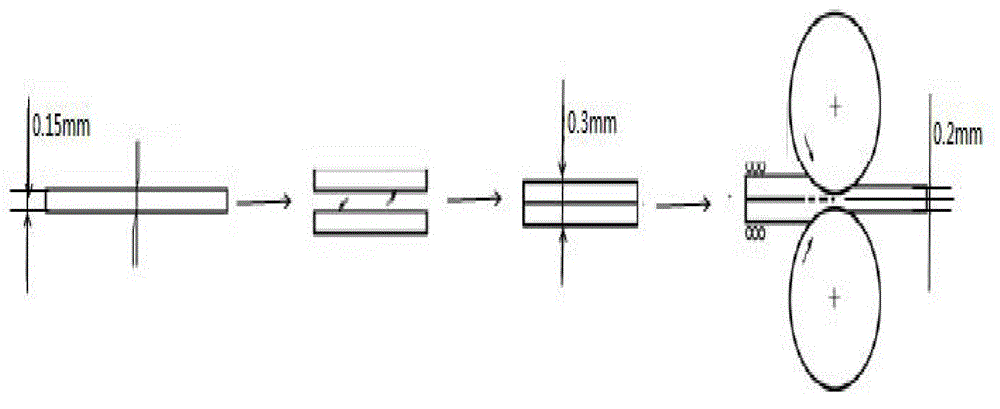A method for preparing high flatness tungsten-nickel-iron alloy plate
A tungsten-nickel-iron alloy and flatness technology is applied in the field of preparing high-flatness tungsten-nickel-iron alloy plates, which can solve the problems affecting the flatness of finished products, the limitation of total deformation, long production cycle, etc. Small, area-increasing effect
- Summary
- Abstract
- Description
- Claims
- Application Information
AI Technical Summary
Problems solved by technology
Method used
Image
Examples
Embodiment 1
[0048] The tungsten-nickel-iron alloy powder after granulation and drying is rolled into a billet, the rolling pressure is controlled at 40KN, and the rolling speed is controlled at 2.5cm / s, and the tungsten-nickel-iron alloy powder is rolled into a thin plate green body with a thickness of 1.8mm .
[0049] The prepared tungsten-nickel-iron alloy thin plate green body is placed in a sintering furnace, and sintered under the protection of hydrogen to obtain a sintered tungsten-nickel-iron alloy thin plate. The sintering temperature is 1300 ° C and the sintering time is 3 hours.
[0050] The sintered body is cold-rolled and rolled, and cold-rolled for several passes until the total deformation of the thin plate reaches 40%.
[0051] Place the cold-rolled tungsten-nickel-iron alloy sheet in a sintering furnace for refiring, the protective atmosphere is hydrogen, the refiring temperature is 1300°C, and the refiring time is 3 hours.
[0052] Repeat the first two steps until the th...
Embodiment 2
[0055] The tungsten-nickel-iron alloy powder after granulation and drying is rolled into a billet, the rolling pressure is controlled at 60KN, and the rolling speed is controlled at 2.0cm / s, and the tungsten-nickel-iron alloy powder is rolled into a thin plate green body with a thickness of 1.6mm .
[0056] The prepared tungsten-nickel-iron alloy thin plate green body is placed in a sintering furnace, and sintered under the protection of hydrogen to obtain a tungsten-nickel-iron alloy thin plate sintered body. The sintering temperature is 1300 ° C and the sintering time is 2.5 hours.
[0057] The sintered body is cold-rolled and rolled, and cold-rolled for several passes until the total deformation of the thin plate reaches 40%.
[0058] Place the cold-rolled tungsten-nickel-iron alloy sheet in a sintering furnace for refiring, the protective atmosphere is hydrogen, the refiring temperature is 1250°C, and the refiring time is 2.5 hours.
[0059] Repeat the first two steps unt...
Embodiment 3
[0062] The tungsten-nickel-iron alloy powder after granulation and drying is rolled into a billet, the rolling pressure is controlled at 80KN, and the rolling speed is controlled at 1.5cm / s, and the tungsten-nickel-iron alloy powder is rolled into a thin plate green body with a thickness of 1.2mm .
[0063] The prepared tungsten-nickel-iron alloy thin plate green body is placed in a sintering furnace, and sintered under the protection of hydrogen to obtain a sintered tungsten-nickel-iron alloy thin plate. The sintering temperature is 1250 ° C and the sintering time is 2.5 hours.
[0064] The sintered body is cold-rolled and rolled, and cold-rolled for several passes until the total deformation of the thin plate reaches 40%.
[0065] Place the cold-rolled tungsten-nickel-iron alloy sheet in a sintering furnace for refiring, the protective atmosphere is hydrogen, the refiring temperature is 1250°C, and the refiring time is 2 hours.
[0066] Repeat the first two steps until the ...
PUM
| Property | Measurement | Unit |
|---|---|---|
| thickness | aaaaa | aaaaa |
Abstract
Description
Claims
Application Information
 Login to View More
Login to View More - R&D
- Intellectual Property
- Life Sciences
- Materials
- Tech Scout
- Unparalleled Data Quality
- Higher Quality Content
- 60% Fewer Hallucinations
Browse by: Latest US Patents, China's latest patents, Technical Efficacy Thesaurus, Application Domain, Technology Topic, Popular Technical Reports.
© 2025 PatSnap. All rights reserved.Legal|Privacy policy|Modern Slavery Act Transparency Statement|Sitemap|About US| Contact US: help@patsnap.com

